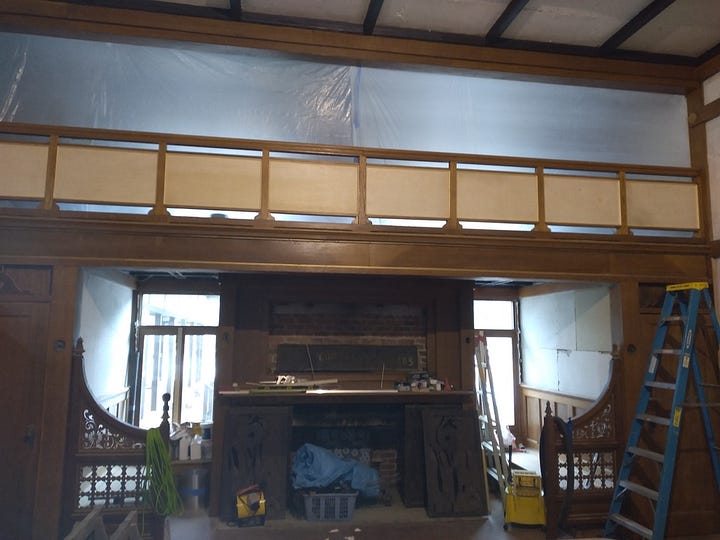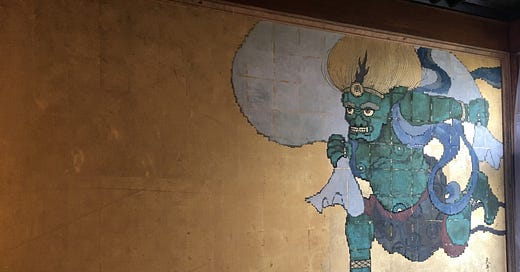This is a bi-weekly section of the newsletter The Curious Kat. Follow along as I write novel #4. If you join me here, you’ll be taking a deep dive in the psychology of drafting long form fiction. Who knows, the process may surprise you. What comes easily and what is hard? What kinds of choices am I making and why?
If you enjoy the post, please click on the heart or comment in the app!
I’m obsessed with the art that was taken from Sho Fu Den. The image above was my favorite panel of all (now gone): Fujin, the God of Wind, who represents fear, respect and the unpredictability of nature. What could be more relevant right now?
I always loved that he’s not centered and the way this injects a sense of dynamism and motion into the picture. Also, this makes the reality of the room in which the viewer is located seem, somehow, just a bit off kilter, or teetering on the edge of something. It invites an expectant feeling. That expanse of aged gold to the left — the emptiness of it — is about to be filled with wind, brought in by a troublesome (though not evil) god, and yet that space is still totally calm.
For now at least. There’s a feeling of waiting, a pause in time, perhaps, but also of something about to happen.
In high school I loved Art History and considered studying it at Cambridge. I was never an especially gifted artist, but images always spoke to me. I loved trying to find the words to express how they altered my perspective on my immediate reality in some magical way. This was when I was 16 years old, and now, many decades later, certain images and designs still have the power to pull me in like that. They actually change my mood, if only temporarily.
For instance, when I started writing this, I was irritable and felt rushed. Now, after staring at Fujin for a while and writing about him, I feel a tickle of excitement in my spine, the beginnings of curiosity emerging like a crocus from frozen ground.
Novelists are nothing if not obsessive
While I’m thinking about how to develop my Sho Fu Den story, I remain obsessed with the murals that bedecked the main hall and the ceilings of the palace rooms.


While the entire system of government aid and grants is being dismantled and arts organizations are losing their funding, I’ve decided to apply for a fellowship from the National Endowment for the Arts. Ha ha.
Actually, I’m serious.
It’s competitive and you can only apply once every two years; I have a friend who was finally awarded a grant after applying every other year for a decade.
My feeling is, what have I got to lose?
What’s fascinating about a process like this is how it forces you to look at your project from a variety of different angles. It’s like trying on a bunch of old clothes in various combinations — what works and what doesn’t? What’s the vibe? What piece is most important?
You keep fiddling until you land on a visual story that works for you on that particular day. In this case, I’m trying to land on an angle, a combination of factors, that make this endeavor interesting to a committee of artists.
Why is it relevant to what’s happening in our world today? Why do I deserve support over any other creative? What lies at the heart of my obsession with this place, the people and the art? How can I persuade someone else of the value of pursuing research about Sho Fu Den, its art and the many fascinating characters who lived there?
This application is streamlined, requiring only 1) up to three sentences “describing how the work will be advanced by the fellowship” and 2) a 25-page excerpt of the work in progress.
That offers very little opportunity for proselytizing or even simply explaining. Mostly what matters is the execution of the idea: are the words on the page evoking something that the committee thinks is meaningful and interesting?
My next task is to fine-tune the 25 pages, but before I launch into that…
… which 3-sentence explanation do YOU prefer?
I’ve come up with two slightly different options to describe my research for this novel/ screenplay. Still a little wordy, but I think I’m getting there.
Which one do you prefer?
This fellowship would make it possible for me to research paintings that disappeared from a Japanese palace built for the 1904 World Fair and moved to the Catskills, NY, by Jokichi Takamine (the first Japanese to marry an American). This derelict palace—which still stands today, against all odds—forms the heart of my dual timeline novel, In the Light of the Ghost Moon, in which I continue my work exploring gender and class expectations, and considering our yearning for identity and belonging. With funding and time off, I’d travel to Japan to learn more about Shugoro Sawabe’s golden murals, connect with experts on artist Katsutsugu Makino, research Takamine (now-forgotten), and delve into the library of philosopher millionaire John Moody, who owned the palace during the Depression, a time of intense anti-immigrant sentiment.
This fellowship would make it possible for me to research muralist Katsutsugu Makino at the Kyoto Institute of Technology, and the paintings of Shugoro Sawabe (which I discovered in a government building in Takaoka) for my novel In the Light of the Ghost Moon. In addition, I’d delve into the library of philosopher millionaire John Moody, and continue research on scientist Jokichi Takamine, the long-forgotten cultural ambassador to the US. These fascinating people were all involved with Sho Fu Den, a Japanese Palace built for the 1904 World Fair which still stands, against all odds, in the Catskills—and forms the heart of my dual timeline novel addressing the common human struggle to defy roles imposed on us by gender, class and culture.
And finally
Working on this little description for the grant has me wondering if the art history angle should play a larger role in my story. Could it be part of the mystery? Should my dual timeline be 1910 and then modern days (vs right after WWII)?
I’m looking for ways to bust the story open, to make it feel more relevant to today’s reader. Please share your thoughts — I’d love to hear how this lands with you.






#2. I love it!
I love your insightful and thoughtful newsletters Katrin. I think number 2 will
appeal to the NEFTA more because of all the historic and scientific research references.